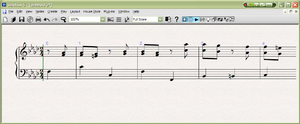Sibelius: Bach Prelude in F minor: Difference between revisions
Jump to navigation
Jump to search
No edit summary |
added additional notes |
||
| Line 12: | Line 12: | ||
Follow [[Media:Sibelius2.pdf |these instructions]] to enter the music/lyrics for the first few bars of J.S. Bach's [http://www.musedata.org/cgi-bin/mddata?composer=bach&edition=bg&genre=keybd/wtc-ii&work=0881&format=pdf&movement=01 prelude in F minor], BWV 881 from Book II of the Well-Tempered Clavier. The final result should look similar to the image displayed to the right. | Follow [[Media:Sibelius2.pdf |these instructions]] to enter the music/lyrics for the first few bars of J.S. Bach's [http://www.musedata.org/cgi-bin/mddata?composer=bach&edition=bg&genre=keybd/wtc-ii&work=0881&format=pdf&movement=01 prelude in F minor], BWV 881 from Book II of the Well-Tempered Clavier. The final result should look similar to the image displayed to the right. | ||
== Additional notes == | |||
=== Chord entry === | |||
Chords can be built in multiple methods using the computer keyboard: | |||
# After typing the lowest note in a chord, press the {{keypress|Shft}} key and then the other pitch names in the chord above it. Each newly added chord tone will be placed above the last entered note of the chord. For example pressing the key sequence {{keypress|c}}{{keypress|C}} will add an octave dyad consisting of two C's. A C major chord in close root position would be {{keypress|c}}{{keypress|E}}{{keypress|G}}. In second inversion the C triad would be entered as {{keypress|g}}{{keypress|C}}{{keypress|E}}. | |||
# Chord tones can also be entered by diatonic interval number. Press a number above the letters on the computer keyboard (not in the numeric keypad) to insert a note into the current chord. For example, {{keypress|3}} will add a note a third above the current note selected (in blue) in the current chord. You can append {{keypress|Shft}} before the number to insert the interval <i>below</i> the current pitch. For example, {{keypress|Shft|3}} will insert a third below the current pitch. If you want to create a C major chord in close root position, but starting with the top note of the chord, try this key sequence: {{keypress|g}}, {{keypress|Shft|3}}, {{keypress|Shft|3}}. Also try this equivalent method: {{keypress|g}}, {{keypress|Shft|5}}, {{keypress|3}}. | |||
# The {{keypress|r}} key is very powerful with working with chords. If you want to repeat a chord, type {{keypress|r}} to repeat it. | |||
# Chords in parallel motion can also take advantage of the {{keypress|r}} command. After duplicating the previous chord, use the {{keypress|Up}} and {{keypress|Down}} keys to modally transpose the chord up or down. | |||
# To repeat chords which are not contiguous (such as having a rest separating them), {{keypress|Shft|Click}} on the chord to copy, then press {{keypress|Ctrl|C}} (or {{keypress|{{Command}}|C}} on a Mac) to copy the chord, then highlight the location where you want to paste the chord and press {{keypress|Ctrl|V}} (or {{keypress|{{Command}}|V}}) to paste the chord. | |||
Latest revision as of 14:40, 26 October 2010

This is the second exercise for entering music in Sibelius using Alphabetic Note Entry. The previous exercise is Mary Had a Little Lamb and the next exercise is a chorale.
This exercise demonstrates how to:
- Create a pickup measure.
- Enter chords with several methods.
- Alter beats in measure without displaying time signature (add "irregular" measures with Alt+b.
- Hide a barline.
Follow these instructions to enter the music/lyrics for the first few bars of J.S. Bach's prelude in F minor, BWV 881 from Book II of the Well-Tempered Clavier. The final result should look similar to the image displayed to the right.
Additional notes
Chord entry
Chords can be built in multiple methods using the computer keyboard:
- After typing the lowest note in a chord, press the Shft key and then the other pitch names in the chord above it. Each newly added chord tone will be placed above the last entered note of the chord. For example pressing the key sequence cC will add an octave dyad consisting of two C's. A C major chord in close root position would be cEG. In second inversion the C triad would be entered as gCE.
- Chord tones can also be entered by diatonic interval number. Press a number above the letters on the computer keyboard (not in the numeric keypad) to insert a note into the current chord. For example, 3 will add a note a third above the current note selected (in blue) in the current chord. You can append Shft before the number to insert the interval below the current pitch. For example, Shft+3 will insert a third below the current pitch. If you want to create a C major chord in close root position, but starting with the top note of the chord, try this key sequence: g, Shft+3, Shft+3. Also try this equivalent method: g, Shft+5, 3.
- The r key is very powerful with working with chords. If you want to repeat a chord, type r to repeat it.
- Chords in parallel motion can also take advantage of the r command. After duplicating the previous chord, use the ↑ and ↓ keys to modally transpose the chord up or down.
- To repeat chords which are not contiguous (such as having a rest separating them), Shft+Click on the chord to copy, then press Ctrl+C (or ⌘+C on a Mac) to copy the chord, then highlight the location where you want to paste the chord and press Ctrl+V (or ⌘+V) to paste the chord.